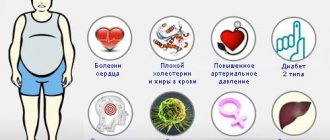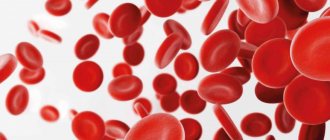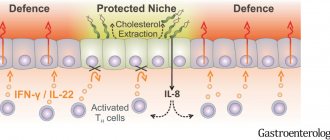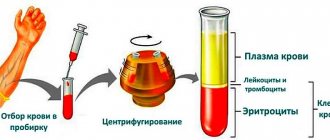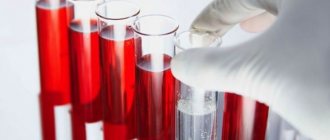Complexes with this research
Extended coagulogram Extended study of the functional state of hemostasis 4,230 ₽ Composition
Planning pregnancy. Clinical indicators 6,800 ₽ Composition
Miscarriage Identification of the main causes of miscarriage RUB 40,440 Composition
IN OTHER COMPLEXES
- Coagulogram RUB 2,080
- Female infertility RUB 16,470
- Examination during pregnancy. 1st trimester 17,040 RUR
- Joining IVF RUB 23,500
- Examination during pregnancy. 3rd trimester 9,840 RUR
Preparing for antithrombin III testing
To ensure the reliability of the result, you must follow the following rules for preparing for the study:
- Blood is taken for analysis on an empty stomach - the last meal should be 12 hours before the test. For children this period of time will be shorter and depends on age;
- before the study, you should exclude physical activity and stress (at least 30 minutes);
- It is not recommended to smoke for half an hour before donating blood for analysis.
Venous blood is used for analysis.
Detailed description of the study
During bleeding, platelets circulating in the blood plasma, with the participation of many clotting factors, form a clot. Along with this, under the influence of thrombin, the fibrin protein is formed, which stabilizes the formed blood clot, after which the bleeding stops.
Antithrombin III is a protein that regulates blood clotting. This protein prevents the formation of blood clots, which is necessary to maintain balance between the coagulation and anticoagulation systems. To this end, antithrombin III binds to enzymes called serine proteases, as well as thrombin, factor IXa and Xa, and inhibits their activity. Sufficient amounts of clotting factors and antithrombin III allow bleeding to be stopped without excessive clot formation.
Antithrombin III deficiency is associated with an increased risk of thrombosis and thromboembolism. It may be hereditary or acquired. According to various estimates, the prevalence of hereditary antithrombin III deficiency ranges from 1 in 2000 to 1 in 5000 cases.
Hereditary antithrombin deficiency is divided into type I and type II. Type I leads to the complete absence of this protein in the blood due to the absence of genes that ensure normal synthesis of antithrombin III. Type II deficiency is characterized by the production of altered protein, which impairs its function. The overall activity of antithrombin III decreases.
Lack of production or incomplete activity of antithrombin III most often manifests itself in the form of deep vein thrombosis. However, there is a risk of repeated sudden thrombosis of atypical vessels, for example, veins of the brain or intestines. The first occurrence of thrombosis occurs at a relatively young age, with the risk of blood clots peaking between the ages of 15 and 40 years. This is especially important against the background of concomitant factors that increase the risk of thrombosis, for example, during pregnancy.
Acquired deficiency of antithrombin III is usually associated with either a decrease in its production in the liver in the case of liver failure, cirrhosis, malnutrition, or with loss of protein by the body in nephrotic syndrome and some other conditions. A decrease in the concentration of antithrombin III is observed in coagulopathies, including disseminated intravascular coagulation syndrome, microangiopathy with thrombosis. In many malignant neoplasms, its production is also disrupted. The use of the anticoagulant heparin significantly increases the activity of antithrombin III, which makes it possible to prevent thrombosis.
The influence of antithrombin III on the body is extensive, so determining the level of this indicator in the blood allows you to avoid the negative consequences of its deficiency and select treatment.
Indications for the study
Antithrombin 3 is synthesized mainly in the upper layer of vascular walls and in the liver and, in combination with heparin, is one of the most powerful blood thinning factors.
Analysis for AT III is indicated in the following cases:
- if heparin is insufficiently effective;
- to determine the causes of thrombosis;
- before antigen test;
- for the diagnosis of autoimmune diseases (in particular systemic lupus erythematosus);
- after removal of the blood clot.
Qualitative and quantitative violations
Low antithrombin III levels are quite rare. According to statistics, there are no more than 1% of such people worldwide. However, of all the pathologies of the hematopoietic system, it is hereditary anticoagulant deficiency that is the most common disorder.
Congenital deficiency of antithrombin III (heterozygous form of the pathological gene) is manifested by the development of thrombosis in people aged 20-35 years. Triggering factors are: pregnancy, childbirth, previous operations or acute inflammation of internal organs, taking hormonal contraceptives. In the homozygous form, thrombosis will develop immediately after birth, but such a disorder is extremely rare.
Acquired antithrombin III deficiency can develop at any time, regardless of a person's age.
A person is not able to independently determine the existing coagulant deficiency, since there are no symptoms of the disorder. The only sign of this pathology will be the formation of thrombosis, but they develop not only with a lack of antithrombin III, but also with other disorders of the hematopoietic system. Moreover, blood clots can form in blood vessels even when the level of Ab III is normal. Simply with its structural changes, antithrombin may cease to perform its functions.
Therefore, quantitative antithrombin III deficiency and qualitative antithrombin III deficiency are distinguished. The first type of disorders is characterized by a low content of antithrombin III in the blood, and the second type is characterized by its functional inferiority. Moreover, in both of these conditions, thrombosis can develop. To find out what exactly led to the formation of blood clots in the vessels, a qualitative study of the antithrombin factor is required.
general information
Antithrombin III is a specific protein, which is one of the main anticoagulants in human blood, predominantly synthesized in the vascular endothelium and liver cells. It prevents excessive blood clotting (up to 75% of plasma thrombin inhibitory capacity) and plays an important role in maintaining normal hemostasis.
Thrombin inactivation is slow and progresses when it acts on its own. In the presence of heparin, the inactivation process occurs very quickly. Therefore, AT III is called a cofactor of plasma heparin. However, in the case of a significant decrease in AT III levels, heparin has virtually no anticoagulant effect. AT III is also active in inactivating factors VIIA, IXA, XA, XIA, XIIA. The mechanism of AT III inactivation is the formation of a complex in which the thrombin molecule and the antithrombin III molecule irreversibly combine. A decrease in antithrombin III levels indicates a risk of thrombosis.
Indications
Antithrombin III testing is most often carried out as part of a coagulogram in the following cases:
- Screening of patients at risk (there were cases of antithrombin deficiency in the family history, thrombosis of veins or arteries was observed before the age of 50);
- Estimation of the amount of functionally useful antithrombin III;
- Thromboembolic pathologies: thrombosis of deep veins or mesenteric vessels;
- myocardial infarction;
- pulmonary embolism;
- stroke;
- thrombophlebitis;
- miscarriage (history);
AT III normal
Standard reference ranges
The antithrombin activity of whole donor plasma is taken as 100%.
| Age | Norms |
| Less than 3 days | 58 — 90 % |
| 3 days – 1 month | 60 — 89 % |
| 1 month – year | 72 — 134 % |
| 1-6 years | 101 — 131 % |
| 6-11 years | 95 — 134 % |
| 11-16 years old | 96 — 126 % |
| More than 16 years | 66 — 124 % |
Norms during pregnancy:
| Gestational age in weeks | Antithrombin III, % |
| 13 – 21 | 74 – 115 |
| 21 – 29 | 73 – 114 |
| 29 – 35 | 76 – 112 |
| 35 – 42 | 70 – 116 |
AT III standards in the independent laboratory Invitro
- For women of childbearing age and men – from 83 to 128%.
Reasons for decreased antithrombin III levels
A decrease in antithrombin III levels can be caused by:
- congenital antithrombin III deficiency;
- Liver diseases with severe liver dysfunction (cirrhosis, liver cancer, etc.);
- Nephrotic syndrome (a number of diseases with significant loss of protein in the urine);
- Massive thrombosis (eg, pulmonary embolism);
- extensive surgery;
- high doses of oral contraceptives, long-term use of heparin;
- DIC syndrome (an acute disorder of all blood coagulation processes that occurs in many critical conditions: shock, severe trauma, burns, massive thrombosis, etc. A slight decrease in this indicator may be the norm in late pregnancy and in the middle of the menstrual cycle.
Regardless of the cause of antithrombin III deficiency, the main clinical symptom is recurrent arterial and venous thrombosis. Hereditary antithrombin III deficiency is mainly characterized by frequent heart attacks and strokes at an early age and the presence of these diseases in the family.
Interpretation of results:
Inherited AT deficiency (less common) is often associated with thromboembolic disease, and acquired AT deficiency (more common) can occur with liver disease, kidney disease, metastatic cancer, and disseminated intravascular coagulation (DIC).
Related Products:
Hemostat Antithrombin liquid
The chromogenic test based on factor Xa allows the quantitative determination of functionally active antibodies even at low levels. Its advantage is that it:
• ready to use
• with reagent stability of 21-25 hours
• insensitive to heparin
References 1. Bhakuni, T., et al., Antithrombin III deficiency in Indian patients with deep vein thrombosis: identification of first India based AT variants including a novel point mutation (T280A) that leads to aggregation. PLoS One, 2015. 10(3): p. e0121889. 2. Khor, B. and E. M. Van Cott, Laboratory tests for antithrombin deficiency. Am J Hematol, 2010. 85(12): p. 947-50. 3. Bauer, K. A., T. M. Nguyen-Cao, and J. B. Spears, Issues in the Diagnosis and Management of Hereditary Antithrombin Deficiency. Ann Pharmacother, 2016. 50(9): p. 758-67. 4. Patnaik, M. M. and S. Moll, Inherited antithrombin deficiency: a review. Haemophilia, 2008. 14(6): p. 1229-39. 5. Funk, DM, Coagulation assays and anticoagulant monitoring. Hematology Am Soc Hematol Educ Program, 2012. 2012: p. 4605. 6. Thachil, J. and C. H. Toh, Current concepts in the management of disseminated intravascular coagulation. Thromb Res, 2012. 129 Suppl 1: p. S54-9.
What can distort the result
The following factors influence the results of the study:
- treatment with heparin and estrogens - they reduce the level of antithrombin in the blood;
- in the case of infectious, viral and inflammatory diseases (including influenza, ARVI, sore throat, rhinitis, etc.), the activity of antithrombin decreases, which also reduces its indicator.
Important! The interpretation of the results is always carried out comprehensively. It is impossible to make an accurate diagnosis based on only one analysis.
Exceeding the norm
- Acute infectious or inflammatory process;
- Diseases of the liver (viral hepatitis, cholestasis) and kidneys, transplantation of these organs;
- Pathologies of the pancreas (acute pancreatitis, oncology);
- Lack of vitamin K in the body;
- Menstrual bleeding (temporary increase, which should be considered normal);
- Therapy with indirect anticoagulants (for example, phenylin, warfarin), anabolic steroids.
Note:
an increase in antithrombin concentration indicates a risk of internal bleeding.
